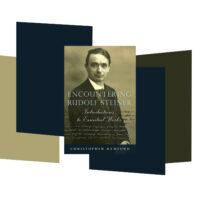Children love to play the game of asking «Why?» without end. Perhaps this is the beginning of the scientific mind. Certain questions have ceased to be asked, though, because they no longer fit within the framework of contemporary science or philosophy. In the first part of this multi-part essay, Matthew Kenyon, a senior technologist at NASA‘s Jet Propulsion Laboratory and longtime student of Anthroposophy, traces the history of philosophy that has led to the way the scientific community asks its questions today.
«We think we do not have knowledge of a thing until we have grasped its why, that is to say, its cause.» – Aristotle1
The Digital Age is an age of facts. In our homes, we ask Alexa in the morning what the weather will be today. Our smart phones provide a stream of updates on current events and internet sales throughout the day. We have virtually endless information available to us through Google. Facts on top of facts. All these facts provide answers to questions we ask. This essay is not about facts. This essay is about the question itself. More specifically, it is about the way we ask questions, tracing the evolution of how we have asked questions from pre-modern times right into our era.
Today, we wade in streams of information flowing from the ubiquitous technological contrivances surrounding us. At the root of our technological era is modern science, which has taught us to ask only certain questions because modern science has taught us to think in a particular way. This very way we think is both the reason for the profound technological progress that defines the modern era and the source of the profound existential problems of modernity: alienation and anxiety within us and strife and conflict between us. This essay explores how we moderns think. It is, in fact, an essay that thinks about thinking. This may appear to be an indulgence in intellectuality (i.e. «how many angels can dance on the head of a pin?»)2, but when we make thinking the object of study, we learn the most important fact that underlies the mountain of facts we scale in our daily life: Thinking is real, and no facts exist without it. When we grasp, in essence, thinking itself, we can actually go beyond facts and recognize that underneath our intellect which dominates our age is our capacity for intuition. This essay is a journey into intuition which lives unnoticed behind the pervasive intellectuality of our modern era.
What does intuition tell us? It tells us that all the things of the sense world that we call facts are facts because we think about them in a particular way. And if we turn to the ‹ultimate facts› of our intellectual culture, then we stand before the atom and DNA, which are viewed today as the foundation of the universe and the essence of life, respectively. This essay makes the case that the atom and DNA are not the ultimate facts they are supposed to be, because our science does not understand thinking itself. How is this case made? By looking at the way we ask questions.

The atom and DNA spring from the sciences of physics and biology which aim to answer the fundamental questions «of what are things made?» and «how does life come into being and evolve?» This essay attempts to show that making the atom and DNA the foundation of the world and of life is an impossibility because such an approach excludes our capacity to think about atoms and DNA. The real question is not ‹what› or ‹how›, but ‹why› can we think about atoms and DNA in the first place? If we draw the boundary of the universe to include ourselves, in addition to merely the world of things around us, we must search for an explanation (e.g. cause) for the foundation of the world and life that explains our intuition. The one-sided explanations of modern science with its exclusive perspective on the outer sense world can never provide this foundation. Instead, as this essay discusses, it is not the atom or DNA that are foundational, but spirit which underlies both the world of the senses and our intuition. Discovery of the spirit in contemporary times is not merely a return to medieval theology, it is absolutely essential to overcome the existential problems – alienation, anxiety, strife, and conflict – which each of us faces today.
Disappearance of ‹Why› Questions with the Rise of Modern Science
Aristotle’s Four Causes as the Foundation for Knowledge
The quest for scientific knowledge is a search for answers to the questions that naturally arise when we turn our attention to the world around us. We are inquisitive about the variegated shape and color of the flowers that meet us in spring, the piercing sounds of song birds that break the silence of the sky, the warming light from the sun that baths our Earth. From the core of our being, an impulse arises within us to ask questions about the natural world. When discussing our inquisitive nature, it is commonplace to bring up the question «why is the sky blue?», but, perhaps surprisingly for those who have not given it much thought, scientists today generally say they do not try to answer ‹why› questions. Instead, scientists say they focus on answers to ‹what› and ‹how› questions. Natural science does not answer the question, for example, «why does the liver exist?», but it asks «what is the material of which the liver consists» and «how does the liver function?» ‹Why› questions are left for philosophers and religions to answer according to the general approach to scientific knowledge today. This approach to knowledge shifted away from the why that preoccupied medieval natural philosophers like Albertus Magnus (b. ~1200) and Thomas Aquinas (b. 1225) who were under the influence of Aristotle’s approach to explain the things of the world. With the rise of modernity, the entire mood surrounding the quest for knowledge of nature changed radically.
Like the modern science that strives to explain the things of the world through cause and effect, Aristotle and the medieval philosophers that succeeded him searched for the causes underlying the phenomena of the world; however, these thinkers, in addition to looking for answers to ‹what› questions, known as ‹material causes›, and ‹how› questions, known as ‹efficient causes›, also looked for answers to ‹why› questions, known as ‹formal› and ‹final causes›. Formal causes relate to the essential nature of things; final causes relate to the purpose or goal of things. To Aristotle, the formal, the material, the efficient, and the final causes are all necessary if we are to possess scientific knowledge of nature, saying, «the student of nature is to bring the why-question back to them all in the way appropriate to the science of nature.»3
Let us look at these four causes more closely, as this will help us understand the foundation of our modern scientific knowledge. Suppose we start with the building of a house. The building materials of the house possess specific properties. Windows are transparent. Bricks are solid. All the specific properties of the materials that constitute the house are the material cause of the house. However, the materials are not sufficient to explain the house. The materials will not change without the builders who use their technical skills to transform the building materials into a house. The skills the builders bring to bear on the working of the materials is the efficient cause. Aristotle, however, sees the blueprint or plan of the house as more fundamental than either the material or efficient causes. The plan of the house lies closer to the essential nature of the house and is called the formal cause. All these prior causes are initiated because of a goal in the mind of the home builder to build a house. The process from planning (formal) to building (efficient) is governed by a goal which is the final cause. The final cause is the purpose behind the activity of the planning and the building of the house.
Purpose is a curious thing. Purpose has the chief characteristic whereby a future cause becomes a present effect. The end of a process is the determining factor in the early steps of the process. Causality, in a sense, flows back through time to when purpose is causative. Clearly, final causes are necessary to explain the human order because human activity is goal-oriented, but the question is whether final causes are necessary explanations in other domains of nature. Aristotle thought so. He saw formal and final causes as essential to explain not just human activities like building houses, but he also saw final causes in the morphology and lifecycle of plants and animals, for example. Acorns aim to become oaks. The egg aims to become a chicken, he thought.

The importance of formal and final causes understood by Aristotle and his medieval followers began to fade through time. Conception of final causes in nature outside of the human order reveals a mood which is more inward and which lends itself to ‹why› questions, which intrinsically do not separate the essence of the questioner from the question. However, thinkers broke from the past mode of relating to the world and became more focused on the external world, bringing a certain kind of conscientiousness to their observations of outer sense phenomena, with an emphasis on discovering mathematical relationships between sense things existing in space. Aristotle prioritized the formal and final cause over the material and efficient cause, looking to the goals in nature. In contrast, the new era was predisposed to merely observe the sense phenomena of nature with ever greater exactitude, looking for answers to ‹how› and ‹what› questions. It is not the question of ‹why› **the Moon exists that became the focus, but ‹how› **does the Moon move through the sky? From this new approach, Nicolaus Copernicus (b. 1473) famously posited that the sun is the center of the solar system, with the planets including the Earth circling this new center. Such a vision of the heavens put distance between the early thinkers of the modern era, like Copernicus and Aristotle who stated that, «It is clear that the earth does not move, and that it does not lie elsewhere than at the center.»4
Nearly a century after Copernicus, Johannes Kepler (b. 1571), Galileo Galilei (b. 1564), and others continued to draw conclusions about nature that diverged from the medieval way of experiencing nature with its reverence toward Aristotle. The supernova explosion of 1604 which was visible to Kepler and Galileo’s naked eye in the daytime, for example, caused them to reconsider the words of Aristotle, «In the whole range of time past, so far as our inherited records reach, no change appears to have taken place either in the whole scheme of the outermost heaven or in any of its proper parts.»5 The discoveries of Copernicus, Kepler, Galileo, and others ushered in a new era where the Earth was seen to move through cosmic space and the heavens could be reckoned with by studying the behavior of earthly things.
Banishment of Formal and Final Causes with the Rise of the Atom and DNA
When matter was no longer seen to consist of heavenly stuff of one quality and earthly stuff of another, but, ultimately, of one uniform substance, the formal and final causes were further buried. The view that earthly and heavenly matter was made of one substance was solidified by Newton (b. 1642) and is captured in the apocryphal story of the falling apple that struck his head. With Newton’s apple, an age was born that concludes that the forces on Earth are the same forces that govern the celestial heavens, which for medieval thinkers and Aristotle were seen as an expression of the spiritual.
From Newton, the modern scientific approach advanced and finally reached the extraordinary discovery of the atom. It is now universality accepted today that the essential nature of the things throughout the universe consists of exceedingly small atoms ruled by a set of fixed forces expressible through mathematical equations. The material cause now has a definitive foundation. We think we know the ultimate answer to the question, of ‹what are things made of?› Atoms and their composite parts. Additionally, the efficient cause now has a definitive foundation. We see the physical forces governing the behavior of atoms as the ultimate answer to the question, ‹how do things in the world change?› The laws of physics ultimately determine how atoms order themselves and evolve through time. The science of quantum mechanics provides the final answers. There need not be a formal or final cause for the foundation of the universe beyond the forces expressed in the laws of quantum physics.
Equally great changes have occurred within the domain of organic nature, which demarks the transition from medieval concepts where formal and final causes were prioritized to explain the vegetative, animal, and human orders of nature. When evolutionary biologists devised theories that explain the origin of organisms and saw humankind as a higher animal, then searching for the final cause was no longer necessary in non-human organic nature. As is well-known to nearly all of us, Charles Darwin’s landmark ‹Origin of Species›, published in 1859, introduced a mechanism that explained ‹how speciation occurs›6. Such thinking was elaborated by other, lesser-known biologists like Ernst Haeckel (b. 1834), who constructed genealogies of the tree of life linking the rise of humankind from simpler life forms, eventually theorizing life itself emerged by chance through the mechanism of natural selection.
The final step in looking at organic nature through merely material and efficient causes was the discovery of DNA. Now the material cause of life was provided a definitive foundation too. DNA is the «secret to life» as the co-discoverers James Crick (b. 1916) and Francis Watson (b. 1916) proclaimed in 1953.7 Moreover, the efficient cause of life which was determined to be the mechanism of natural selection was seen to link closely to the material cause of DNA. Natural selection works through random mutations of DNA and these mutations become adaptations if the mutated DNA of individual members of species are better able to propagate.
We have arrived at the modern scientific outlook that proclaims nature has no goals. Today, purpose outside the human domain is not seen as a necessary cause to explain the content of the natural order. In fact, the purposes of Aristotle are seen as naive anthropomorphism of the natural order that stem from unclear thinking or worse, superstition. There is no reason to assume future goals act as present causes, because the mechanism of natural selection working through DNA provides such a convincing explanation of the material cause (DNA) and the efficient cause (natural selection) for the life found in the plant, animal, and even the human kingdoms. DNA, in turn, is supported by the findings of quantum physics where the foundation of matter is subatomic particles governed by physical forces.
Title image Junion, Unsplash
Footnotes
- Aristotle, Physics, 194 b 17-20.
- How many angels can dance on the head of a pin?
- Aristotle, Physics, 198 a 21–23.
- Aristotle, On the Heavens, Part 14.
- Aristotle, On the Heavens, Part 3.
- Charles Darwin, On the origin of species by means of natural selection, (London: J. Murray, 1859).
- Words of Francis Crick as conveyed in the following book: Howard Markel, The Secret of Life, (New York: W.W. Norton Company, Inc. 2021.)










Wow Matthew this is just an exquisite wonderful outline of the separation between ‘Why’ and everything else. Kids who are always asking ‘why’ are often tagged as a “disturbance to the class” by today’s psychology either or labeled as “on or off the spectrum”, whatever that means? Often ‘why’ kids are just interested in ‘why’ things happen and the how is not as important to them as it drives them deeper into their intellect where the materialistic comparative/competative measure/testing and analysis of everything gives them No answers about ‘why’ they or anyone/thing exists. In today’s world we have absolute segregation/separation by the smallest minute’s variations between minerals planets plants people ie “DNA to Atoms”. Perhaps our modern educators will eventually understand that connecting these disparate sciences about how/what relates to the real “why” question that initially arises in our progenitors, rather than just labeling and ostracizing them to the fringes of our ever increasing psychologically dysfunctional civilisation.